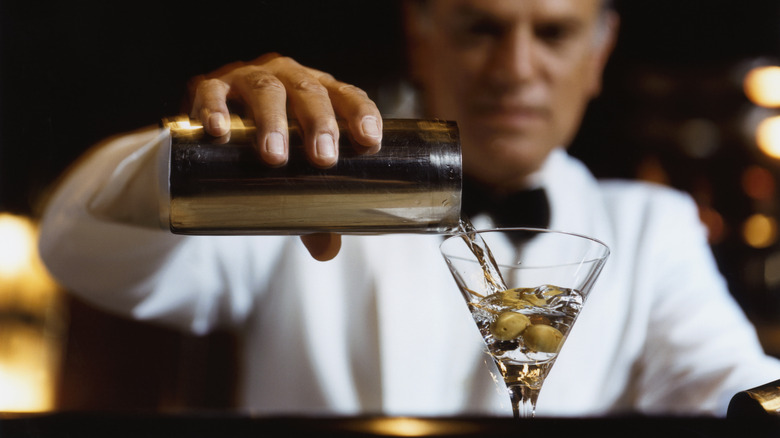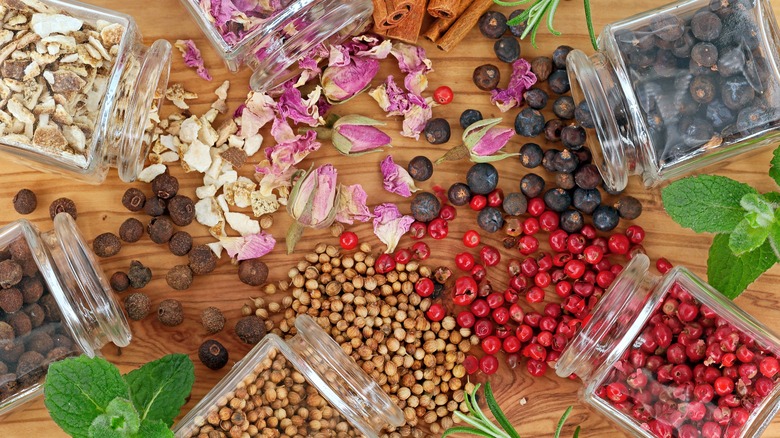Here's The Actual Difference Between Vodka And Gin
If you tour a gin distillery, it's very likely the first words you'll hear from the guide will be, "gin is essentially flavored vodka." While it's an accurate enough shorthand, the rest of the tour will be spent explaining why gin and vodka are actually so very different. Despite beginning with similar ingredients and fermentation processes, the two classic spirits take different journeys to the bottle.
Vodka and gin both begin as a fermented grain or fruit "beer" or "wine" that is then distilled into a higher proof neutral spirit. From there, the differences happen right away. Both tradition and production regulations — from distillation techniques to the addition of the juniper and other botanicals — share the ultimate goal of making gin a distinctive product with its own character, aromas, and flavors. While each spirit pairs nicely with tonic and vermouth, and works well in a dirty martini, there are good reasons why you might prefer yours with vodka or gin, and not the other way around.
Vodka (mostly) emphasizes neutrality
Vodka is sometimes scoffed at by cocktail aficionados. But it's basically the Ur-spirit, as it can be distilled from any fruit, starch, sugar, or grain, and very little is done with it once it's been brought to proof. Though historically and today, most vodka is distilled from wheat or potatoes, it can be produced from corn, apples, honey, milk sugars, quinoa, barley, or grapes, just to begin with. Contrast that with spirits defined by specific ingredients or aging requirements, like bourbon (which must be at least 51% corn, made in America, and barrel aged) or tequila (at least 51% Blue Weber agave, made in designated states in Mexico).
In the United States, vodka is defined by the TTB (Alcohol and Tobacco Tax and Trade Bureau) as a neutral spirit, distilled at or above 95% alcohol by volume (ABV), or about 190 proof, and made from any material. The proof drops with the addition of water, but not below 80% ABV / 40 proof. Though the TTB's precursor, the Bureau of Alcohol, Tobacco, and Firearms defined vodka as having no "distinctive character, aroma, or taste," beyond that of alcohol, the rules have since relaxed. The fact is the base ingredients impacts the subtle flavors and aromas of the "neutral" spirit. Differing distillation methods, viscosities, and perceptions of alcohol heat also influence the taste of a given vodka. Thankfully, more producers are exploring these characteristics and their potential in the finished drink.
Gin is all about the botanicals
The thing that makes gin what it is are the botanicals: seeds, leaves, stems, spices, citrus peels, and just about anything else that someone can throw into a still with a high-proof neutral spirit, influencing the flavor. The most important ingredient is the juniper berry. With classic London Dry gin (which can be made anywhere), juniper must be the dominant aromatic note. Other categories of gin can dial back that piney, oily note. So if you don't like London Drys, consider a category like New Western Dry gin which tends to be more floral.
Any number of botanicals can be thrown into the mix. The label may note how many different ingredients are used, but the most common, after juniper, tend to be angelica root, orange peel (dried or fresh), coriander, orris root, and anise or other licorice element. After that, it's anyone's game. You'll find gins incorporating grape flowers, local indigenous plants, even pepper. The botanicals may be introduced into the fermented mash bill and distilled along with the initial "beer," or added to a distilled neutral spirit (vodka) to macerate or soak for hours or days. Delicate ingredients, like flowers or cucumber, can be placed in a steam basket, with the evaporated distilled spirit running through it, adding subtle flavors. It's also possible to simply soak botanicals in a finished spirit and absorb the aromas and flavors that way.
Additional differences between vodka and gin
There is another unaged spirit from which gin and sometimes vodka are made: grain neutral spirit (GNS). Essentially a high-proof vodka made from grains, it is often bought in bulk and rectified (re-distilled and filtered) to create a smoother vodka. It's often used by small brands to put their own stamp on a bulk spirit, or large brands to get someone else to do the first round or two of distillation. Rather than using a finished vodka, gin makers very often take advantage of re-distilling a less expensive GNS.
For the most part, vodka and grain neutral spirits are distilled in long coffey or column stills, designed to affordably produce multiple distillations, creating a high-proof, "clean" distillate. Pot still (bulbous stills with long necks or coils) generally produce a heavier distillate with more retained flavors and a higher viscosity. There are pot still-finished vodkas which display a little more character and body. If the gin botanicals are macerated, rather than steamed, they almost certainly sit in a pot still full of GNS for a day or so before re-distillation.
For these reasons, you may prefer one spirit or the other in cocktails. Gin will generally be more full-bodied, aromatic, viscous and flavorful, balancing a complex drink like a negroni. Vodka seamlessly adds structure to other cocktail ingredients without overly influencing the flavor of the drink, which is why it's nice in a fruity drink like the sea breeze.



